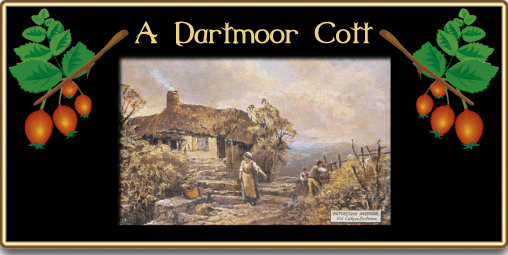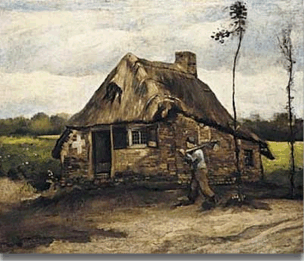
Every now and again I allow myself the luxury of imagining I have won the National Lottery and then browsing through the property pages of the Devon Life Magazine. There age pages of glossy moorland cottages all with totally surreal blue skies and colourful gardens, each one labelled with a sale price that is totally out of the reach of any local resident. At the moment I would estimate that you would need in the region of £400,000 to purchase a half tidy abode on Dartmoor. Amazingly these properties don’t sit around too long and much of the time they are purchased as second homes or weekend cottages – I cannot imagine where people get such money. But this is the 21st century and we are civilised people – or are we? Try telling the moorfolk of the 19th century that their cotts would be worth six figure sums and you would instantly be labelled as ‘mazed’. Granted their humble dwellings didn’t have the ‘mod cons’ of today but they certainly had the views and the benefit of living on Dartmoor. So let’s step back a couple of hundred years and look at the humble cotts and the cottars. The first thing to establish is that at this time Dartmoor was considered a ‘waste’ and the moor dwellers as ‘ignorant peasants’, the picturesque had not yet arrived on the moor – or had it? In 1797, the Reverend Swete (pp. 63 – 64) described a cottage he came across at Cator:
“… it was composed of turf and peat; … whose walls were formed of Stones, not cemented by Lime, but having the interstices filled, by mud, or by some what analogous to it, as here, peat.
… and such is Old Cators on Dartmoor – rough and shattered as it was, it yet possessed much of the Picturesque in its appearance… The door entered into a portion appropriated to the Winter reception of cattle belonging to the farm, from thence I past directly into the Kitchen, which was lighted by a sort of window, at the further end was a large Chimney in which blazed a cheerful Peat fire; of which fuel as it rose at their door they did not seem to be sparing. Near the entrance I observed a ladder which I concluded, must lead to the bed chamber; up this I ran, and found it to be so, in the singular number – for it consisted but of One, about 20 feet in length and half that space in breadth; in there were ranged five beds in which, without the interposition of Screens or curtains, the Old Man, his Son, and others amounting to four men, and five Women, every night took their rest.
In this picture of primitive Simplicity and Purity, with the circumstance of Cattle being sheltered under the same roof with their Master, converting only Spelunca into tugurium, (Cave into Cottage)…“
It would seem that here we have a description of a small Devon longhouse whereby half of the house was used to house livestock and the other half being the living quarters Which as noted above was a simple kitchen above which was a single bedroom accessed by a ladder. This type of dwelling was by no means exclusive to Dartmoor and could at one time be found in many upland areas of Britain. Typically the earlier longhouses simply had a single entrance which led to a simple division. On one side the structure had cattle stalls with a drainage channel sloping down. Although these days the idea of having livestock under the same roof may sound repugnant there were certain advantages. Firstly the animals provided an extra heat source for the building as the warmth from their bodies somewhat added to the fire. It also meant in severe winters the animals were close by for feeding and milking which saved a lot of time. In later periods there was a more substantial division between the livestock and the humans by solid walls on each side of the passageway. To get a good idea of a typical Devon Longhouse the Dartmoor National Park Authority have hosted a virtual tour of one such structure at Uppacott which can be found – HERE
In 1838 Mrs Bray (p.139) penned the following lines which today would surely secure her a job with any estate agent:
“A Devonshire cottage, if not too modern, is the sweetest object that the poet, the artist, or the lover of the romantic could desire to see. The walls, generally of stone, are grey, and if not whitewashed, (which they too often are,) abound with lichen, stone-crop, or moss. Many of these dwellings are ancient, principally of the Tudor age, with the square-headed mullioned and labelled windows. The roof is always of thatch, and no cottage but has its ivy, its jessamine, or its rose mantling its sides and creeping on its top. A bird cage at the door is often the delight of the children; and the little garden, besides its complement of hollyhocks, &c., has a bed or two of flowers before the house of the most brilliant colours. A bee-hive, and the elder, that most useful of all domestic trees, are seen near the entrance…“
This is what will set you back £400,000 today but a few years later the same author (1844, p. 22) describes a completely different picture:
“… the sod is also useful in another way, since a good deal of it is employed in the building of huts, generally composed of loose stones, peat, and mud, in which the few and scattered peasantry of the moor are content to make their dwelling. A hardy and inoffensive race, they at no very remote period, were looked upon as being little better than a set of savages; and to this day they are assuredly a very rude and primitive people… Imagine a hut, low and irregular composed of the materials above-named, and covered with a straw roof, or one not unfrequently formed with green rushes, so that at a little distance it cannot be distinguished from the ground on which it stands. Near the hut there is often seen an out-house, or shed, for domestic purposes, or as a shelter for a cart if the master of the tenement is rich enough…“

My, how things change, perhaps its not all hollyhocks and clotted cream after all and maybe the bird in the cage was roasted for Sunday dinner? But believe me it gets better?
“The manners of the peasantry may in some measure be estimated by their dwellings. They are not overclean; and though they are surrounded on all sides by mountain-streams and rills of the purest water, I have generally found, close to their doors, as if they delighted in the odour it produced, a pool into which are thrown old cabbage leaves and every sort of decaying matter.
Out of these huts, as you pass along, you will see, running to gaze upon you, some half-dozen or more children, not overburdened with clothes, and such as they have, like Joseph’s coat, being often of many colours, from the industrious patching of their good mothers. The urchins, no doubt, are not bred up as Turks, since frequent ablution makes no part of their devotion. Now and then, however, you find a clean face, which is as rare as a dry day on Dartmoor; and when in this case, it is generally found worth keeping so, as it discloses a fine, fat, round pair of cheeks, as red, – I must not say as roses though writing to a poet, for the simile would be much to delicate for my Dartmoor cupids, – but as red as a piece of beef, which is a great deal more like the cheeks in question. Legs and arms they have that would suit the infant Hercules…”
Despite being described as a “set of savages,” it would appear that recycling and the compost heap was no modern contrivance to the ‘hut dwellers’. In some cases the explanation for such rude dwellings was the Dartmoor practice of ‘squatter’s rights’. This was a tradition whereby if a man could build a house in a day and have a fire lit in the hearth by the evening he could claim the house and the land upon which it stood as his own. Probably the best known example of this on Dartmoor is Jolly Lane Cott although there are other ruins of such buildings such as Sam Parr’s House.
Cott, longhouse or hut they were all people’s homes and it appears that over the last two hundred years or more opinions have taken them from the ‘hovel’ to the ‘romantic’. This change has altered as the general idyllic conception of the rural picturesque became more popular. Today it seems that the Dartmoor Cott is seen as a status symbol especially where the houses are only used at weekends.
 Legendary Dartmoor The many aspects past and present of Dartmoor
Legendary Dartmoor The many aspects past and present of Dartmoor
